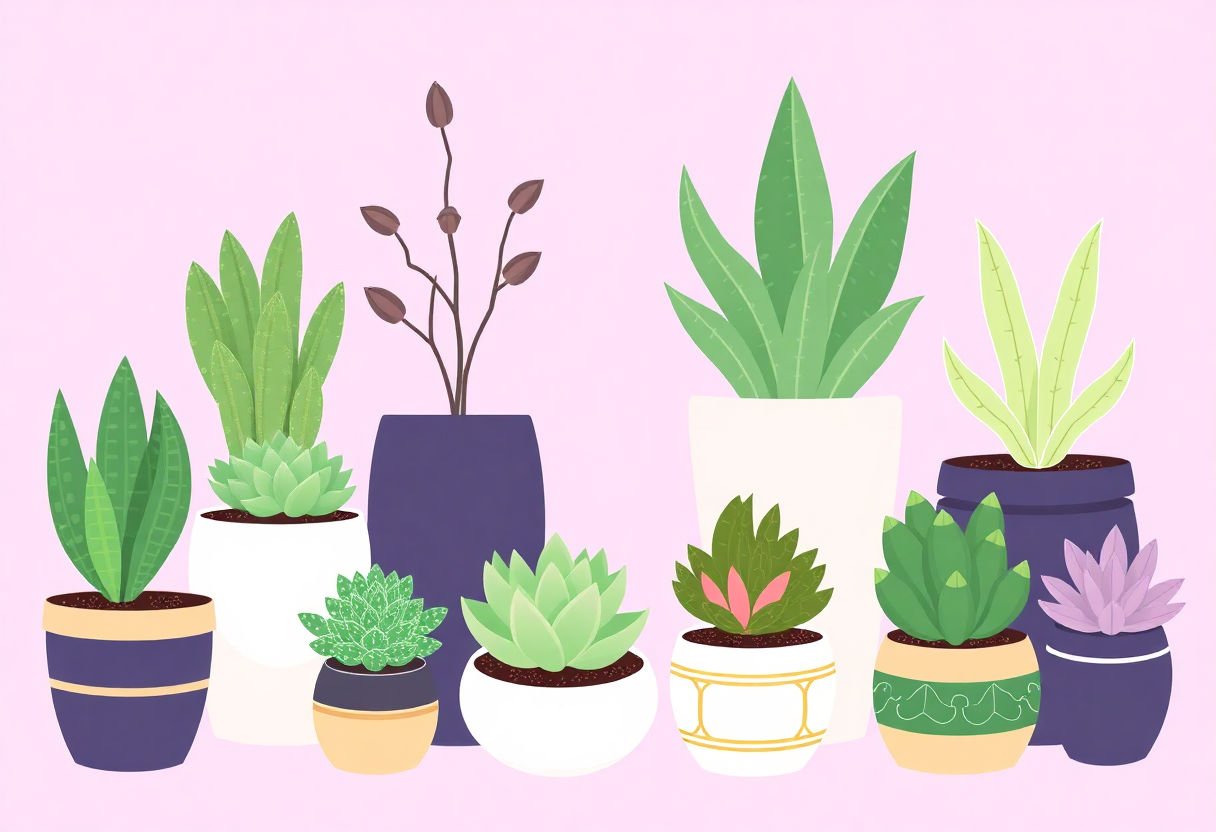Creating beautiful spaces with succulent plants and diverse pot styles has never been easier. These plants, known for their thick leaves, thrive in pots of all kinds. From clay to concrete, pot choice affects their growth and look. Drainage is vital for their health, while different materials and styles bring unique touches to your space. By pairing various succulents in one pot, you can design stunning arrangements. Matching them with your interior decor, you craft a cohesive look. Learn how seasons affect care and discover ways to recycle pots. Dive into endless possibilities with succulents and pots.
Key Takeaways
- Succulent characteristics guide the choice of pots for better display and health.
- Pot materials like ceramic, terracotta, and concrete offer unique looks and drainage needs.
- Mixing succulent types in one pot enhances visual appeal and design.
- Matching pot and plant colors with room decor creates a cohesive look.
- Recycled materials as pots provide eco-friendly options for garden creativity.
Understanding Succulent Characteristics
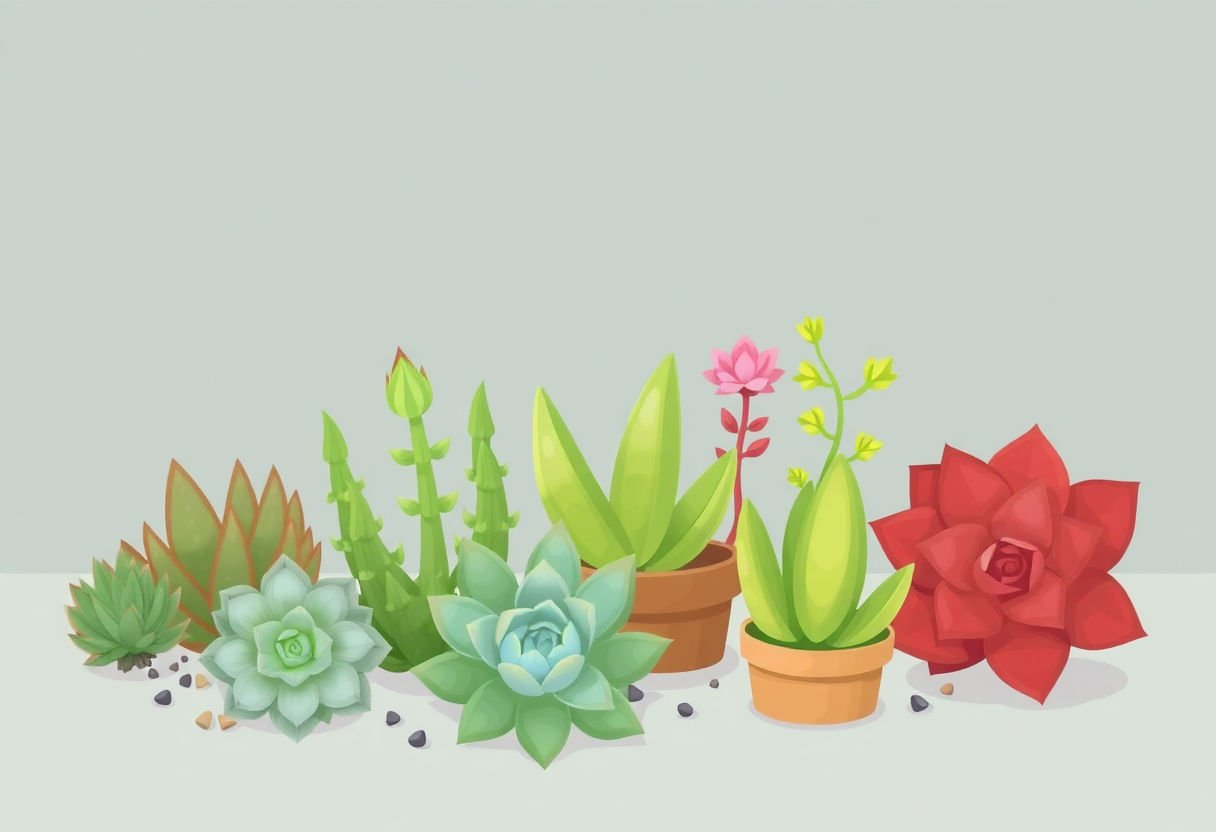
Succulents catch the eye with their unique traits. They come in all shapes and sizes, from tiny rosettes to sprawling vines. Each type offers its own charm, making them popular for pots.
These plants have thick leaves. They hold water, letting them thrive after infrequent watering. Resilience describes succulents well. Their leaves often feel firm, like a balloon filled with air. This distinct feature helps prevent water loss.
Color plays a role too. Succulents can be green, red, purple, or even blue. Some have stripes or spots. These colors can affect the look of your pot arrangement.
Texture differs among succulents. Some leaves feel smooth like polished stones, while others might be fuzzy like a peach. These textures add depth and interest to any display.
When choosing a pot, think about the size of the succulent. Smaller succulents suit small pots or groups in larger containers. Larger ones need more space to spread out.
Light needs vary by type. Some prefer bright light, while others thrive in partial shade. Consider this when placing them with certain pots.
You can mix different succulents together. It’s like creating a miniature garden in a pot. Mixing types with different heights or shapes builds visual interest. Here are a few examples:
- Tall sedum with a rosette-shaped echeveria
- A trailing string of pearls alongside compact haworthia
- Rosy hens and chicks popping against a green jade plant
Understanding these characteristics sets the stage for creative pot pairings. It’s about letting each plant shine in its own way.
Exploring Pot Materials and Styles
When choosing pots for succulents, you have many materials to consider. Each one offers different looks and benefits. Ceramic pots come in many colors and styles. They work well for adding a splash of color. These pots are heavier, which makes them stable.
Terracotta pots are quite popular. They have a warm, earthy tone. This matches the vibe of succulents well. Terracotta also breathes well, helping prevent over-watering.
Concrete pots offer a modern, sleek look. They are durable and often used in contemporary settings. They keep the soil cool and can handle outdoor conditions.
The style of the pot also plays a big role. Think about the pot’s shape and its effect on how your plant looks. Round pots work nicely for single plants. Larger ones group multiple succulents together, creating an eye-catching display.
Consider using tall pots for plants with trailing leaves. They give the plant room to grow and hang beautifully over the edges.
Texture adds interest to your pot display. Smooth, glazed surfaces offer a clean look. Rough, unglazed surfaces give a rustic feel. Consider the overall theme of your space when choosing textures.
When it comes to color, think of the plant’s hues. A neutral pot allows the plant’s colors to shine. A pot with a contrasting color creates a bolder display.
Selecting the right pot changes how a plant stands out. The right choice boosts the beauty of your succulents and your space.
The Importance of Drainage
Proper drainage is like a magic trick for keeping succulents healthy. These plants come from places with little rain, so they do not like sitting in water. Without the right drainage, their roots can rot, leading to a sad-looking plant. It’s like wearing rain boots in a puddle—if water cannot escape, your feet get soaked.
When choosing a pot, look for one with holes at the bottom. These holes let excess water flow out. A plain terracotta or ceramic pot usually has these holes. If your favorite pot doesn’t have holes, use a drill to gently add some.
Layers matter too. Start with small stones or gravel at the pot’s bottom. This layer helps keep roots dry by allowing water to escape more easily. Above the stones, add a compost or soil mix made for succulents or cacti. This type of soil is dry and helps water move through quickly.
Here are some tips to help with drainage:
- Choose pots with drainage holes.
- Place a layer of pebbles or gravel on the bottom.
- Use special soil mixes for succulents.
Keeping a balance between too much water and not enough is key. A plant with good drainage is like a happy camper with the right gear. It thrives and grows strong.
Mixing Succulent Varieties for Visual Appeal
Combining different types of succulents in one pot creates a pleasing look. Think of it as putting together a puzzle. Each piece has a different shape and color, but together, they form a beautiful picture. You can achieve this by mixing tall and short succulents, fat and thin ones, or those with round or pointed leaves.
Here are some tips to help you:
-
Size Matters: Place taller succulents in the center or at the back. Use smaller ones at the front. This setup allows all plants good sunlight and shows off every plant.
-
Color Play: Look for succulents in a range of hues. Green is great, but add purples, reds, or blues for contrast. This variety grabs attention and keeps things interesting.
-
Texture: Pick succulents with different leaf surfaces. Some leaves look smooth and waxy, while others appear spiky or fuzzy. Using various textures makes your plants more lively.
-
Spacing: Do not pack them tightly. Allow room for each one to grow. This spacing ensures healthy plants and keeps their colors and shapes visible.
An example arrangement might feature tall jade plants beside shorter hens and chicks. Adding a few string of pearls draping over the edge of the pot. Every succulent adds to the display, like parts of a well-balanced meal. Mixing different succulents not only fills your space with beauty but offers something intriguing for anyone who passes by.
Matching Colors with Interior Decor
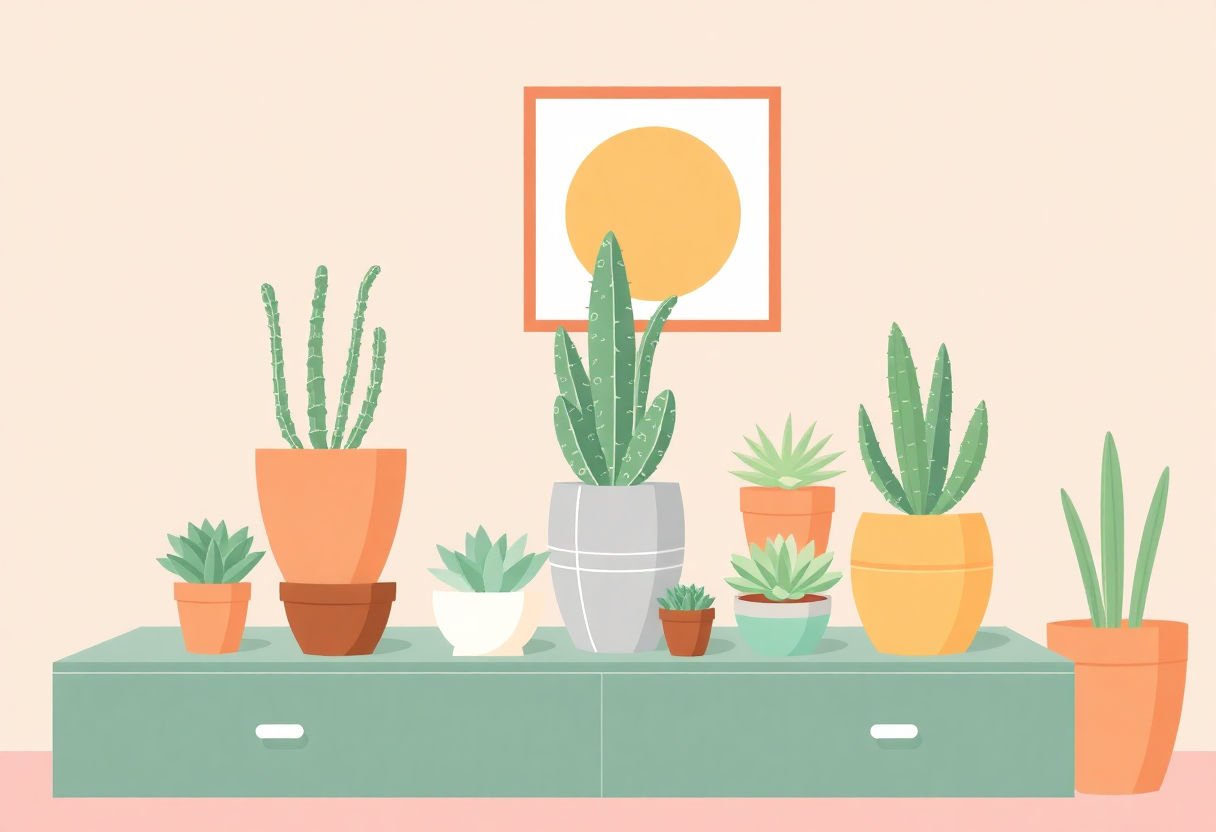
Matching the colors of succulents and pots to your home decor creates a cohesive look. Start with the room’s color palette. Think about the walls, furniture, and accents. Then, choose succulents and pots that complement these colors.
Neutral tones are a safe choice. Gray, white, and beige pots fit well in almost any space. They let the succulents’ natural hues stand out. Use green succulents with these pots to add life without clashing.
For a pop of color, pick pots that match an accent in the room. If your space has teal pillows, try teal pots. This creates harmony without overwhelming the room.
Mix earthy succulents like Echeveria with terracotta pots for warm tones. Match these with wood furniture to create a natural vibe. Plants like blue chalk sticks can add a cool contrast to these warm hues.
If your room is mostly one color, such as gray, try pots with different shades of that color. Light gray pots with dark gray succulents create depth. This keeps the look interesting and sleek.
Remember, not all pots need to match exactly. A mix of patterns and solid colors can be refreshing. Just keep some repetition in the colors to avoid chaos.
In the end, trust your eye. Choose combinations that make you happy and fit well together. Your space should feel welcoming and well-thought-out.
Creating Themes for Outdoor Displays
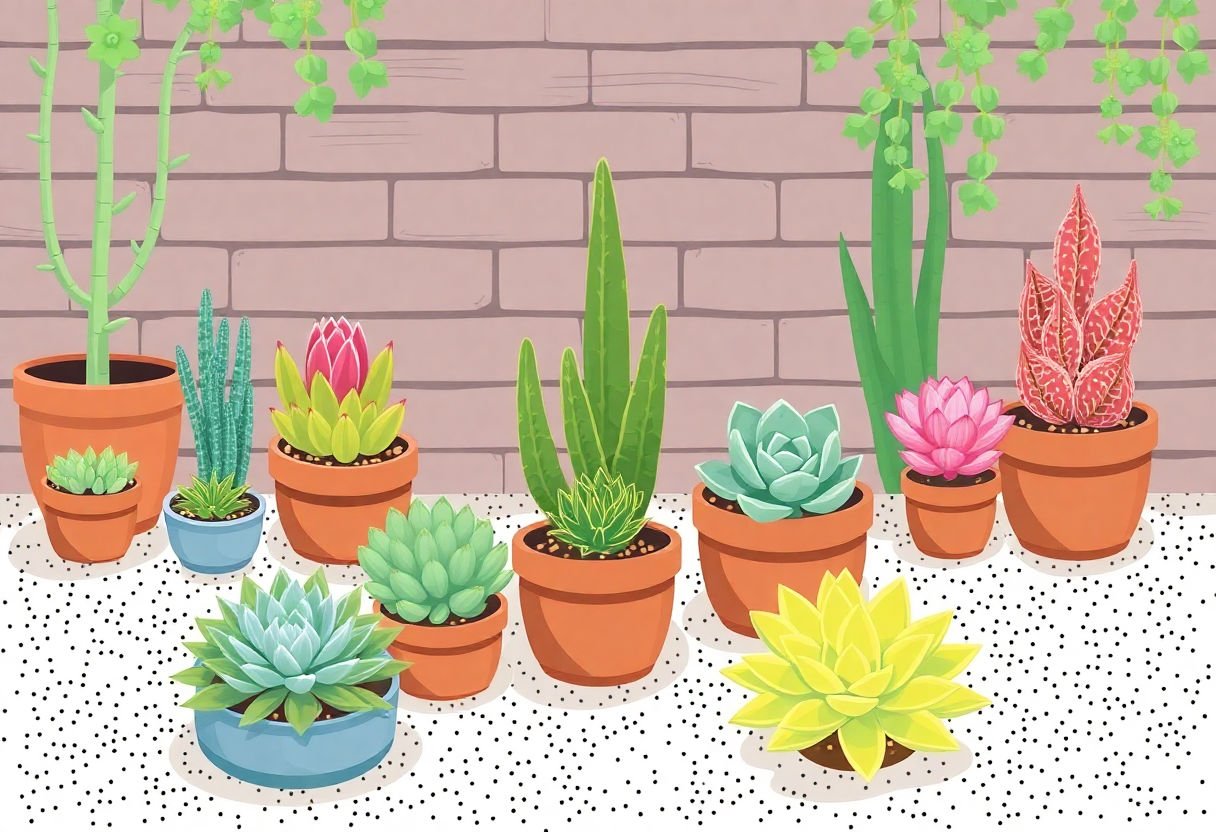
Creating themes for outdoor displays with succulents adds charm to your garden. Start by picking a theme that matches your outdoor space. Here are some ideas to get you started:
Desert Theme
A** desert theme** works well in dry climates. Use sand-colored pots with cacti and aloe. Spread fine gravel over the soil to mimic the desert. Arrange rocks around the pots to add character.
Tropical Theme
For a tropical feel, include vibrant pots. Choose succulents like jade plants and bright bromeliads. Add some large leaves or ferns around the display. This creates the lush vibe of a rainforest.
Minimalist Style
A** minimalist approach** needs simple pots and limited colors. Use all-white or black pots. Arrange succulents like echeveria in neat lines. Avoid clutter to keep it clean and modern.
Rustic Look
To make rustic displays, pick worn-out pots. Old wooden containers fit well. Mix in some aged ceramic pots. Use succulents with a gray or dusty look, like ghost plants.
Create a Vibrant Arrangement
- Use pops of color with both pots and succulents.
- Mix textures with smooth and bumpy pot surfaces.
- Vary heights by using stands or hanging pots.
Lighting also affects how your display looks at different times of day. Soft, warm lights highlight textures in the evening, while daylight brings out the colors.
No matter the theme, let your personality shine through. Mix and match elements to create a space that feels unique to you.
Seasonal Considerations for Succulent Potting
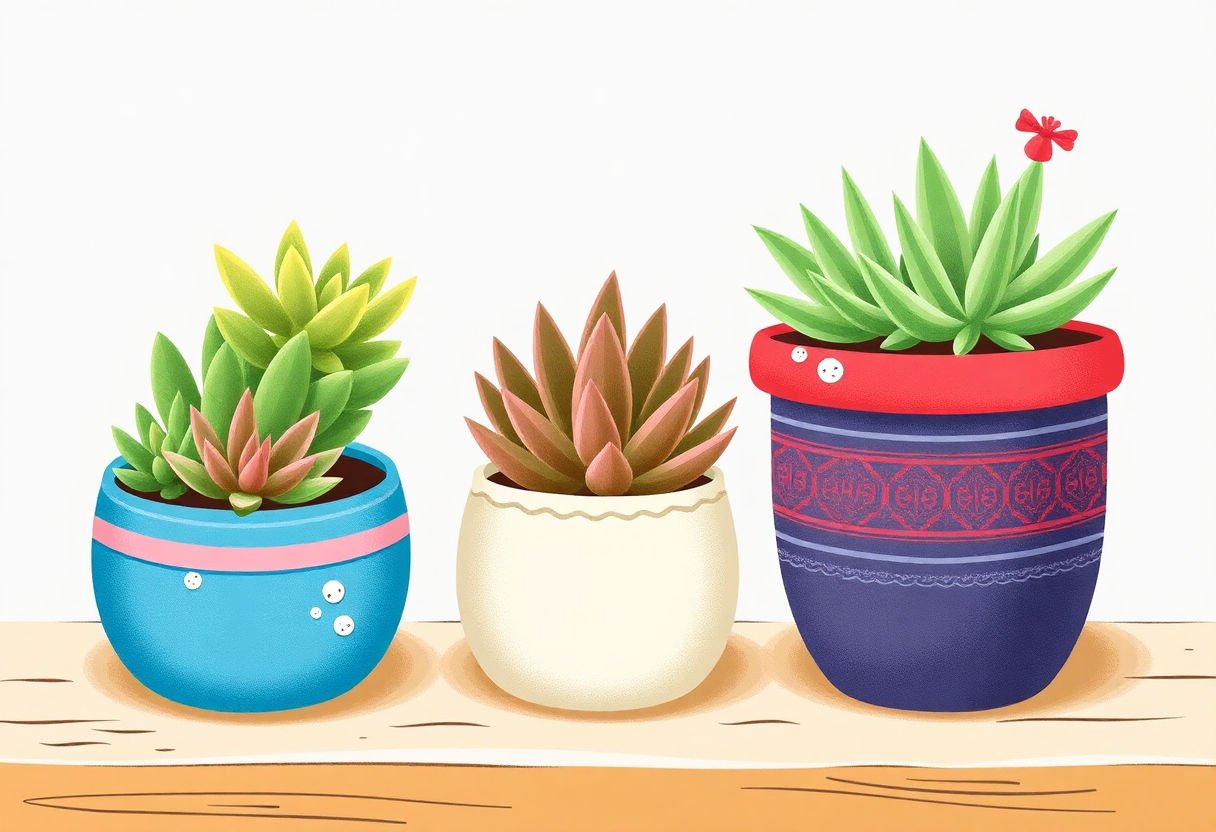
As the seasons change, so do the needs of your succulent plants. In the warmer months, succulents love to soak up the sun. Spring and summer serve as the perfect time for them to grow. Consider using clay pots. These pots help with quick drying because they breathe. They also keep roots cool.
Transitioning to fall, cooler days and longer nights begin. This may mean less sunlight for succulents. Move them indoors or closer to windows. Adjust water routines. Cut down on watering as the temperature cools. They don’t need much water when it’s not warm.
In winter, succulents go into a form of rest. They require little to no watering during this phase. Choose pots that offer ample drainage. You can use ceramic pots with drainage holes. These work well. They keep water from sitting at the base and help avoid root rot.
For dry, cooler climates, think about metal pots. These pots warm quickly in the sun. They help keep the soil dry. Perfect for succulents.
Here are some useful tips:
- Sunlight: Move your pots to catch more light.
- Water: Reduce water as weather cools.
- Pot Choice: Pick pots that suit the weather—clay for warm, ceramic or metal for cooler times.
Taking these seasonal steps keeps succulents healthy and lovely all year round. Adjust with each season, and they’ll continue to thrive.
Sustainable and Recycled Pot Ideas

Using recycled items as pots for succulents brings a touch of nature to your home. Plus, it helps the earth. You can find creative pots from things you no longer use.
Old shoes make quirky pots. They have space for soil and often have natural drainage. Fill them with succulents for a playful look.
Tin cans also work well. Just clean them and drill a hole in the bottom. Then, paint them if you like. They are sturdy and have good size for smaller plants.
Broken mugs or cups can find new life as pots. Even if chipped, they hold soil well. Arrange them on windowsills or shelves for an artsy display.
Wooden crates or boxes can also be great. Line them with plastic to keep the wood safe from water. These work well for bigger plants or groups.
Think about glass jars. Use old jam jars or mason jars. They let you see the plant’s roots and soil. This adds an extra layer to your plant display.
Using recycled pots for succulents not only helps nature but also adds personal style to your space. It ties together the cozy warmth of your home and your love for the earth. Plus, it shows how you turn the ordinary into something special. Bold your choices by selecting materials that tell a story.
Conclusion
Mixing and matching succulent plants with different pot styles opens up a world of creativity. By understanding their characteristics and pot materials, one can craft unique displays. Proper drainage and color matching ensure healthy plants and aesthetic appeal. Experiment with themes based on seasons and sustainability for diverse looks. Let this guide inspire you to create satisfying and beautiful succulent arrangements. Your personal touch can turn any space into a lively and vibrant area. Enjoy the journey with your succulent garden.
Frequently Asked Questions
How do I know which pot style suits my succulents best?
Consider the size and shape of the succulents. Small round pots can highlight rosette-shaped succulents. Long, shallow pots can emphasize trailing types. Think about the plant’s growth when choosing the pot.
Is drainage really that important for succulents?
Yes, drainage is crucial. Succulents dislike sitting in water. It can lead to root rot. Always select pots with a drainage hole or add pebbles at the bottom.
Can I mix succulents with different water needs in one pot?
It’s best to group succulents with similar water needs. This makes care easier. Some succulents need less water than others, so it can be tricky.
How can I match pot colors with my interior decor?
Think about the colors in your home. Earthy tones like brown and beige blend well. Bright colors can make succulents pop.
What are some sustainable potting options for succulents?
Use recycled materials like old bowls or containers. They make unique pots. You can also choose pots made from eco-friendly materials.
